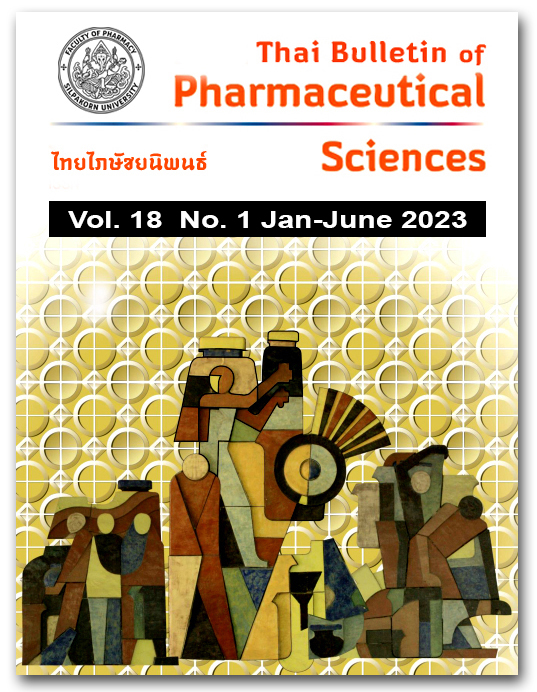การศึกษาผลลัพธ์ทางคลินิกและอัตราการตายในผู้ป่วยวิกฤตที่ได้รับยา meropenem จากภาวะพิษเหตุติดเชื้อ หรือภาวะช็อกจากพิษเหตุติดเชื้อ
DOI:
https://doi.org/10.69598/tbps.18.1.71-86คำสำคัญ:
เมอโรพีเนม, การติดเชื้อแบคทีเรีย, mSOFA score, ภาวะพิษเหตุติดเชื้อ, ภาวะช็อกจากพิษเหตุติดเชื้อบทคัดย่อ
ภาวะพิษเหตุติดเชื้อ (sepsis) และภาวะช็อกจากพิษเหตุติดเชื้อ (septic shock) มีอัตราการเสียชีวิตที่สูง ปัจจุบันมีการนำยา meropenem มาใช้ในการรักษาแบบคาดการณ์ในผู้ป่วยที่มีภาวะ sepsis และภาวะ septic shock การศึกษานี้มีวัตถุประสงค์การศึกษาเพื่อ 1) ศึกษาเชื้อสาเหตุของภาวะ sepsis หรือภาวะ septic shock ในผู้ป่วย ณ หน่วยอภิบาล (ไอซียู) 2) ศึกษาผลลัพธ์ทางการรักษาของผู้ป่วย 3) ศึกษาปัจจัยที่มีผลต่ออัตราการเสียชีวิต และ 4) ศึกษาความสัมพันธ์ระหว่างค่าคะแนน delta mSOFA (คะแนน mSOFA ที่เปลี่ยนแปลงระหว่างวันที่หลังการได้รับยา meropenem กับวันที่ 1) กับอัตราการเสียชีวิตในผู้ป่วยที่ได้รับยา meropenem การศึกษาเป็นเชิงสังเกตแบบเก็บข้อมูลย้อนหลัง ณ โรงพยาบาลพระพุทธบาท ระหว่าง มกราคม พ.ศ. 2561 ถึงเดือน พฤศจิกายน พ.ศ. 2564 ผู้ป่วยที่เข้าเกณฑ์การศึกษามีจำนวน 74 ราย ทำการเก็บข้อมูลคะแนน mSOFA วันที่ 1, 2, 4, 7 และ 10 ของการได้รับยา meropenem ร่วมกับติดตามอัตราการเสียชีวิตที่ 14 และ 28 วัน ผลการศึกษา พบเชื้อจุลชีพก่อโรค 3 อันดับแรก คือ Escherichia coli ร้อยละ 35.1 carbapenem-resistant Acinetobacter baumannii ร้อยละ 20.3 และ Klebsiella pneumoniae ร้อยละ 18.9 ผู้ป่วยมีอัตราการเสียชีวิตที่ 14 และ 28 วัน ร้อยละ 25.7 และ 39.2 ตามลำดับ การวิเคราะห์พหุตัวแปรพบปัจจัยที่มีผลต่ออัตราการเสียชีวิตที่ 28 วัน ได้แก่ ค่าคะแนน delta mSOFA ระหว่างวันที่ 4 กับวันที่ 1 น้อยกว่าหรือเท่ากับ -1 (Odd ratio;OR 0.02, 95% CI [0.00,0.20]), septic shock (OR 9.15, 95% CI [1.57,53.26]), และ ความเหมาะสมของการใช้ยา meropenem ตามความไวของเชื้อ (OR 0.01, 95% CI [0.00,0.10]) โดยสรุป การศึกษาพบว่าอัตราการเสียชีวิตของผู้ป่วย sepsis หรือ septic shock ที่ได้รับยา meropenem ค่อนข้างสูง ทั้งนี้การได้รับยา meropenem ที่เหมาะสม สภาวะ และความรุนแรงของความเจ็บป่วย ส่งผลต่ออัตราการเสียชีวิต
เอกสารอ้างอิง
Cecconi M, Evans L, Levy M, Rhodes A. Sepsis and septic shock. Lancet. 2018;392(10141):75-87.
Singer M, Deutschman CS, Seymour CW, Shankar-Hari M, Annane D, Bauer M, et al. The third international consensus definitions for sepsis and septic shock (Sepsis-3). JAMA. 2016;315(8):801-10.
Plevin R, Callcut R. Update in sepsis guidelines: what is really new? Trauma Surg Acute Care Open 2017;0:1-6.
Grissom CK, Brown SM, Kuttler KG, Boltax JP, Jones J, Jephson AR, et al. A modified sequential organ failure assessment score for critical care triage. Disaster Med Public Health Prep. 2010;4(4):277-84.
Gholipour Baradari A, Sharifi H, Firouzian A, Daneshiyan M, Aarabi M, Talebiyan Kiakolaye Y, et al. Comparison of proposed modified and original sequential organ failure assessment scores in predicting ICU mortality: a prospective, observational, follow-up study. Scientifica (Cairo). 2016;2016:7379325.
Baharoon S, Telmesani A, Tamim H, Alsafi E, Aljohani S, Mahmoud E, et al. Community- versus nosocomial-acquired severe sepsis and septic shock in patients admitted to a tertiary intensive care in Saudi Arabia, etiology and outcome. J Infect Public Health. 2015;8(5):418-24.
Indrawattana N, Vanaporn M. Nosocomial infection. J Med Health Sci. 2015;22:81-90.
ศูนย์เฝ้าระวังเชื้อดื้อยาต้านจุลชีพแห่งชาติ (NARST) สถาบันวิจัยวิทยาศาสตร์สาธารณสุข กรมวิทยาศาสตร์การแพทย์. สถานการณ์เชื้อดื้อยาต้านจุลชีพปี 2000-2019.Available from: http://narst. dmsc.moph.go.th/data/AMR%202000-2019-12M.pdf
Zhanel GG, Wiebe R, Dilay L, Thomson K, Rubinstein E, Hoban DJ, et al. Comparative review of the carbapenems. Drugs. 2007;67(7):1027-52.
Seok H, Song J, Jeon JH, Choi HK, Choi WS, Moon S, et al. Timing of antibiotics in septic patients: a prospective cohort study. Clin Microbiol Infect. 2020;26(11):1495-500.
Khwannimit B, Bhurayanontachai R. The epidemiology of, and risk factors for, mortality from severe sepsis and septic shock in a tertiary-care university hospital setting. Epidemiol Infect. 2009;137(9):1333-41.
Zhou J, Qian C, Zhao M, Yu X, Kang Y, Ma X, et al. Epidemiology and outcome of severe sepsis and septic shock in intensive care units in mainland China. PLoS One. 2014;9(9):e107181.
Angkasekwinai N, Rattanaumpawan P, Thamlikitkul V. Epidemiology of sepsis in Siriraj Hospital 2007. J Med Assoc Thai. 2009; 92(Suppl2): S68-78.
Santimaleeworagun W, Wacharasint P, Saelim W, Suphanklang J, Duangmee K, Ruenroengbun N, et al. Clinical outcomes and mortality risk factors among intensive care unit patients with bacteremia at a university hospital. SEHS. 2021:21050008-.
Ahmed N, Jen S-P, Altshuler D, Papadopoulos J, Pham VP, Dubrovskaya Y. Evaluation of meropenem extended versus intermittent infusion dosing protocol in critically ill patients. J Intensive Care Med. 2020;35(8):763-71.
Lertwattanachai T, Montakantikul P, Tangsujaritvijit V, Sanguanwit P, Sueajai J, Auparakkitanon S, et al. Clinical outcomes of empirical high-dose meropenem in critically ill patients with sepsis and septic shock: a randomized controlled trial. J Intensive Care. 2020;8:26.
Napolitano LM. Sepsis 2018: Definitions and Guideline Changes. Surg Infect (Larchmt). 2018;19(2):117-25.
Mira JC, Gentile LF, Mathias BJ, Efron PA, Brakenridge SC, Mohr AM, et al. Sepsis pathophysiology, chronic critical illness, and persistent inflammation-immunosuppression and catabolism syndrome. Crit Care Med. 2017;45(2):253-62.
Sapra A, Malik A, Bhandari P. Vital Sign Assessment: StatPearls [Internet]. Treasure Island (FL): StatPearls Publishing; 2022.
Liang C-A, Lin Y-C, Lu P-L, Chen H-C, Chang H-L, Sheu C-C. Antibiotic strategies and clinical outcomes in critically ill patients with pneumonia caused by carbapenem-resistant Acinetobacter baumannii. Clin Microbiol Infect. 2018;24(8):908. e1-. e7.
Katip W, Uitrakul S, Oberdorfer P. A comparison of colistin versus colistin plus meropenem for the treatment of carbapenem-resistant Acinetobacter baumannii in critically ill patients: a propensity score-matched analysis. Antibiotics. 2020;9(10):647
McKenzie C. Antibiotic dosing in critical illness. J Antimicrob Chemother. 2011;66(2):25-31.
Cotta MO, Roberts JA, Lipman J. Antibiotic dose optimization in critically ill patients. Med Intensiva. 2015;39(9):563-72.
Shahrami B, Sharif M, Sefidani Forough A, Najmeddin F, Arabzadeh AA, Mojtahedzadeh M. Antibiotic therapy in sepsis: No next time for a second chance! J Clin Pharm Ther. 2021;46(4):872-6.
Martinez ML, Plata-Menchaca EP, Ruiz-Rodriguez JC, Ferrer R. An approach to antibiotic treatment in patients with sepsis. J Thorac Dis. 2020;12(3):1007-21.
Dugar S, Choudhary C, Duggal A. Sepsis and septic shock: Guideline-based management. Cleve Clin J Med. 2020;87(1):53-64.
Sendagire C, Lipnick MS, Kizito S, Kruisselbrink R, Obua D, Ejoku J, et al. Feasibility of the modified sequential organ function assessment score in a resource-constrained setting: a prospective observational study. BMC Anesthesiol. 2017;17(1):12.
Öz E, Saltürk C, Karakurt Z, Adıgüzel N, Güngör G, Devran Ö, et al. Risk factors for multiorgan failure and mortality in severe sepsis patients who need intensive care unit follow-up. Tuberkuloz ve toraks. 2015;63(3):147-57.
Vélez JW, Aragon DC, Donadi EA, Carlotti AP. Risk factors for mortality from sepsis in an intensive care unit in Ecuador: A prospective study. Medicine. 2022;101(11):e29096.
Harris PNA, Tambyah PA, Lye DC, Mo Y, Lee TH, Yilmaz M, et al. Effect of piperacillin-tazobactam vs meropenem on 30-day mortality for patients with E. coli or Klebsiella pneumoniae bloodstream infection and ceftriaxone resistance: a randomized clinical trial. JAMA. 2018;320(10):984-94.
Kim YJ, Kim SI, Hong KW, Kim YR, Park YJ, Kang MW. Risk factors for mortality in patients with carbapenem-resistant Acinetobacter baumannii bacteremia: impact of appropriate antimicrobial therapy. J Korean Med Sci. 2012;27(5):471-5.



